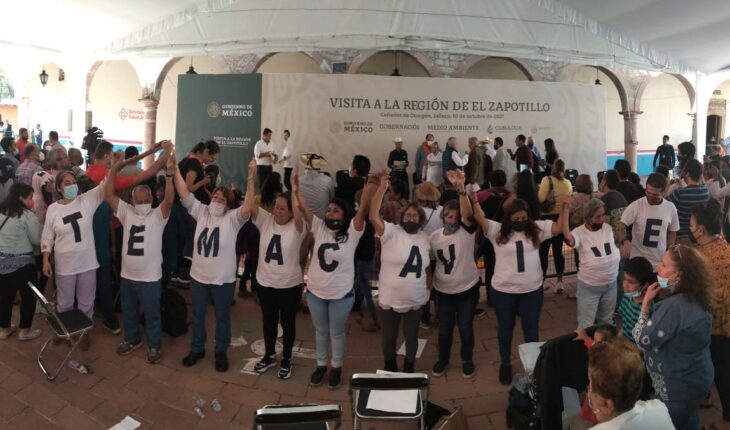“Temaca lives, the struggle continues. Temaca lives, the struggle continues”, was the phrase that inhabitants of Temacapulin, Palmarejo and Acasico chanted while some tears were present. The villagers made a decision on the El Zapotillo dam. In reality, they maintained the same as in the last 16 years: the villages are not flooded by the Zapotillo Dam.
The only difference is that they will accept the activation of this, as long as the maximum water level reached 48 meters high.
The decision was made public at the meeting of this Sunday, October 10, of the inhabitants with the President of Mexico, Andrés Manuel López Obrador. His decision was presented as a counterproject of what was proposed by the National Water Commission (Conagua) last August.
In that month, the idea raised was that the dam will operate at 80 meters high, but the inhabitants specify that it must be at a height of 48 meters.
To ensure that this height is maintained and avoid an overflow, they request the construction of a landfill similar to the “U” that is formed in the laundries, explain the inhabitants. With this, they would have the opportunity for the water to come out of the dam and not overflow.
In case the authority does not agree, the villagers propose an option “b” that is a tunnel, so that the water can leave.
You may be interested: Video: These are the communities that fight not to be underwater at the El Zapotillo Dam
In their counterproposal, they also ask for the integral reparation of the damage that includes the reconstruction of the homes of Palmarejo, the public apology, the commitment of the night repetition, the integration of programs to help the inhabitants, the denomination of magical town and the technical financial audit of the El Zapotillo Dam project.
Gabriel Espinoza, one of the representatives of Temacapulin recognizes “we are aware that this decision is a watershed”. And he insists that accepting the use of the dam under any situation does not imply the construction of a height of 105 meters for the dam.
Mrs. Isaura, who also represents the people of Temacapulin, said that if necessary they will request the signatures of the municipal presidents, the governor and the State Congress to ensure that the agreements are respected.
Cristian Gómez, representative of Palmarejo points out that being the town that has been despija of their lands they need resources to return to the site. “Those who know Palmarejo know that it is in ruins, we have nowhere to go,” Cristian insists.
For his part, the leader of Conagua, Germán accepted the counterproposal and explained that a review of technical details will be made to make it possible.
Finally, President Andrés Manuel López Obrador added”there is already a decision not to flood the three villages, I think that’s a breakthrough… I make the budget with you that we are going to review the proposal with you and I think it is important that the technical studies gathered on alternative options continue, if you need budget I can guarantee it“.
The president also asked for respect for the governor of Jalisco, Enrique Alfaro, who attended the event and was not well received by the residents.
According to the villagers, if the governor and the president had not arrived in the same van, Alfaro would not have passed. They even turned their backs on the governor to show the phrase “Temaca lives.”
The annoyance of the inhabitants is due to the governor rejecting the repeated invitations made to him to listen to the problems of Temacapulin. And to his constant changes of position on the construction of and his changes of opinion on non-construction, and then if he imposed it.
For August 23, a week after the first presidential visit, the head of the National Water Commission (Conagua), Germán Martínez Santoyo presented the proposal to leave the curtain (wall) of the dam at 80 meters high and with an operation close to 50 meters so as not to affect the 3 towns.
With that, the water collection capacity is reduced to 90 million cubic meters and would be water only for the Guadalajara Metropolitan Area. This proposal also includes the creation of the El Purgatorio dam to be able to pump the collected water that reaches the capital.
It was also proposed that the diversion channels not be covered, so as not to fill the dam.
The decision made by the villagers was first reviewed by technicians who accompany them, so that the federal authority does not lie to them.
Currently the work does not have a budget established in the Budget of Expenditures of the Federation (PEF) of 2022. Claudio, member of the Mexican Institute for Development Community (IMDEC), explains that this does not affect at the moment, because by the process after the decision it is not known how long the studies of the final decision may take.
4 days before and almost 2 months after the presidential visit, Conagua delivered the requested information and height measurement to verify that the communities are not at risk
16 years of struggle
In 2005 the then president of Mexico, Vicente Fox, announced a mega work, the construction of the El Zapotillo dam. Which was intended to bring water from the Río Verde to the Metropolitan Area of Guadalajara, the region of Los Altos in Jalisco and the neighboring state of Guanajuato.
Doing so implied evicting 3 towns: Temacapulín and Palmarejo -located in the municipality of Cañadas de Obregón, in Jalisco-, and Acasico -located in the municipality of Mexticacán, also in Jalisco-. That is, about 400 families are affected XXX.
For 16 years, the villagers have made their position clear: they do not agree with the mega project and say no to the flood.
The struggle undertaken is mostly made up of older people and is supported by young people who have had to migrate in search of economic opportunities, who dream of returning to spend their old age and who have been called the collective “Absent Children”.
At first, the federal authorities and the states of Jalisco and Guanajuato explained that the dam would be located between Yahualica and Cañadas de Obregón, and would have a height of 80 meters, so that by only placing some containment dams they could continue to inhabit the site.
Later, they learned from the media that the curtain would be 105 meters.
If it were left with a height of 80 meters and functioned at full capacity, the towns of Palmarejo and Acasico – from which its inhabitants have already been evicted – would be flooded and the only ones who would remain in their homes are the inhabitants of Temacapulín.
If built with a height of 105 meters, it will flood all the villages.
The authority even began the construction of Talincoyuque, a new property where it is intended to move the inhabitants of Temacapulin. Currently, seven families live who report that they do not have basic services.
Therefore, over the years the inhabitants have promoted 15 federal injunctions, but the work is still under construction and even works at THE XXX of its capacity.
The inhabitants insist that this project does not favor them because in addition to displacement, it would imply losing their culture and their forms of sustenance: the thermal water spas, the hectares in which they produce chili and the hectares of cultivation that are for self-consumption.
While state authorities insist that it is a project that will benefit 2.4 million people and that sports events or commercial fishing can be done to generate income, although it has not specified an economic plan for it.
The current Governor of Jalisco, recognized in August 2021 that there was no “Plan B” if the inhabitants did not accept the curtains at a height of 105 meters.
Read more: El Zapotillo Dam endangers three communities in the highlands of Jalisco
They die of uncertainty
Jorge Gutiérrez, an academic at the University of Guadalajara, details that 26 residents of Temacapulín died between 2005 and 2010 due to the El Zapotillo dam process.
The specialist, accompanied by a team of 50 experts, documented that in the five years that had passed since the beginning of the struggle, chronic stress, hypertension and depression increased among the inhabitants, as well as anxiety, worry and sadness.
The study was carried out thanks to the fifth administrative court requesting a psychosocial opinion from the inhabitants on the issue of forced displacement.
Gutiérrez narrates that the authority gave them a month and a half, a very short time to make an opinion of such magnitude, so 50 social psychology professionals had to participate to make multidisciplinary teams.
The academic adds that the accompaniment has been for longer, but that it is the only official study they have presented of the case.
“This situation, sustained for many years, did generate emotional alterations accompanied by violence, suffering, anguish, anxiety, demoralization, difficulties in facing daily and problematic situations, generating conditions of emotional and physical vulnerability, both to people and collectively.
That situation, of anxiety, of uncertainty, also generated longer-term stress that is associated with chronic degenerative diseases, even in some cases the deterioration especially in adults and older adults became such that some died, “says Gutiérrez.
The results indicate that 80% of the peopleLadores in Temacapulín had post-traumatic stress.
Among the symptoms they presented was excessive alertness, startles in places to sleep, irritability, feeling of strangeness, fear of loss of control, headache, tachycardia, lightheadedness and exhaustion.
Despite this, Gutiérrez adds, the villagers did not receive psychological attention or socioeconomic support for their care, knowing that it was an affectation to the life project and that it is a violation of a right documented by the Inter-American Commission on Human Rights.
Gutierrez indicates that 16 years after maintaining the struggle, the inhabitants surely have greater affectations.
The academic insists that the struggle in which they have prevailed “indicates the cultivation of a congruence and a strength of the people of Temacapulín in defense of their territory.”
What we do at Animal Político requires professional journalists, teamwork, dialogue with readers and something very important: independence. You can help us keep going. Be part of the team.
Subscribe to Animal Político, receive benefits and support free journalism.#YoSoyAnimal





